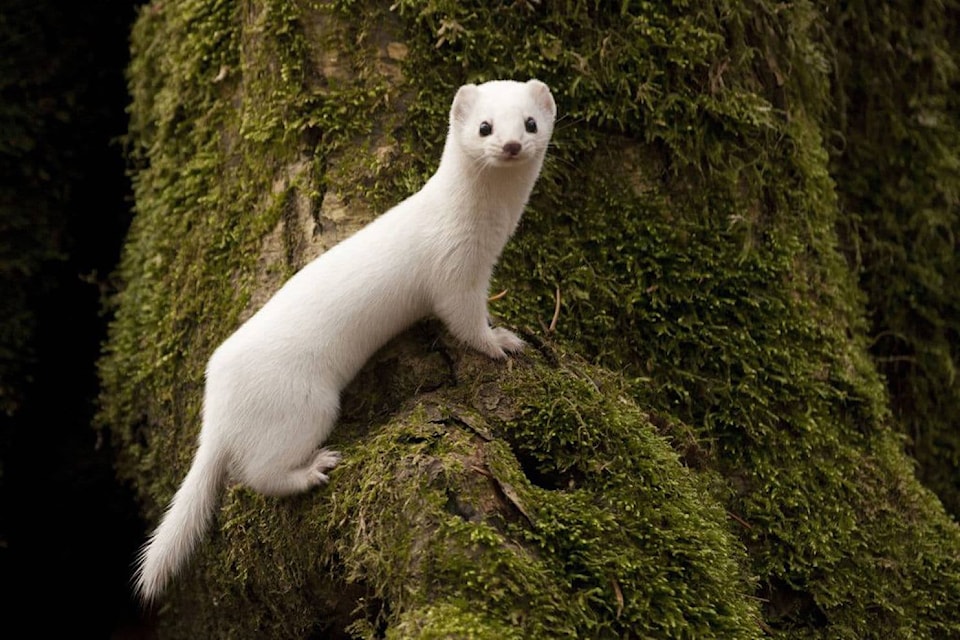The best-preserved remnant of primeval European woods is the Bialowieza Forest, which grows along the border of Poland and Belarus. A World Heritage site since 1979, the 550-square-mile forest covers an area larger than the city of Phoenix. Wolves and rare European bison walk beneath the old-growth trees. Scurrying lower to the ground are Mustela nivalis, also known as least weasels.
Camouflaged fur helps the weasels avoid wolves and other predators. In the Bialowieza Forest, the least weasel comes in two subspecies. One wears a brown coat all year. The other sheds its brown coat each autumn into a bright winter white, an adaptation to blend in with snow.
But there was no snow cover when biologist Karol Zub, at the Mammal Research Institute of the Polish Academy of Sciences, observed an entirely white weasel hunting rodents. Its fur stood out in sharp contrast to the green moss. “At this very moment, I thought to myself: ‘Wow! If this animal is so well visible, it must be a perfect target for predators,” Zub said.
His instincts were right. Snow no longer blankets the forest for as long as it once did, Zub and his colleagues wrote in a new paper published Thursday in the journal Scientific Reports. And there are fewer white weasels.
The team captured 118 weasels in the forest between 1997 and 2007. “In our study, the densities of weasels are about four to five times lower than 10 years ago,” he said. As the number of days without permanent snow cover increased, the proportion of white weasels dropped precipitously.
This drop is a case of what wildlife biologists call camouflage mismatch: White fur, which should be a stealthy trait, becomes a vulnerability when there’s no snow. “Camouflage mismatch may cause the local extinction of white subspecies,” Zub said, or at least a severe reduction in population.
L. Scott Mills, a wildlife biologist at the University of Montana who was not involved with this study, called it a “fascinating and important paper.” Mills has studied color mismatch in snowshoe hares, which also turn white in winter. The hares’ probability of surviving through the week decreased by as much as 7 percent when their camouflage did not match their environment, Mills and his co-authors reported in Ecology Letters in 2016.
Dips of just a few percentage points might not seem like a major problem, but the cumulative effect over a winter period can “seriously influence the mortality of this species,” Zub said.
There are 21 species known to change the color of their coats in winter, Mills said, including six species of hares, three weasel species, hamsters, lemmings and arctic foxes. He predicts the other coat-changers are faring about as poorly as the snowshoe hares and least weasels.
In the new work, the study authors analyzed weather data in the Bialowieza Forest going back to 1967. The average period with permanent snow cover decreased from about 80 days per year to 40 days. Historically, the snow cover vanished around March 16. But in recent years, it disappeared by Feb. 21, more than three weeks earlier in the season.
Zub and the other co-authors conducted a field experiment to observe whether predators were hunting the exposed white weasels. Because using real weasels was impractical, they constructed mock weasels out of cheap toy rats purchased from Ikea, slimmed and elongated into more weaselly silhouettes.
They placed model brown weasels and model white weasels in front of camera traps, either in snow cover or on bare ground. Five species of predators - buzzards, common ravens, gray wolves, raccoon dogs and red foxes - detected the models. The predators were far more likely to attack, sniff or otherwise harass the mismatched weasel models, particularly the white weasels in areas without snow.
All this has happened before. A well-known case of coloration mismatch occurred in a population of peppered moths in the 1800s. During the Industrial Revolution in Great Britain, soot blackened the trees and other surfaces of moth habitat. Birds began to pick off these moths, betrayed by their light wings. But some peppered moths developed a mutation that turned their wings black. Those insects blended in, survived and multiplied.
In the warm Polish forests and soot-covered Britain, “the mechanism of natural selection is exactly the same,” Zub said. Those who blend in live longer. Individuals who clash with their environment are eaten.
Like the mutant moths, a few weasels are adjusting. Normally, Zub said, the weasels molt into white in November. But now they are delaying their wardrobe switch. “About half of weasels we observed last winter started to molt at the beginning of January.”
Life on Earth is reacting to climate change. Bears appear to be hibernating for fewer days. Tropical fish are swimming away from the equator in search of cooler waters. Some animals have moved up mountains to escape increased temperatures. Some plant species are creeping downward to embrace it.
But camouflage mismatch might be one of the most glaring effects. After all, it’s hard not to notice a flash of white fur in a dark forest.
Ben Guarino/The Washington Post
